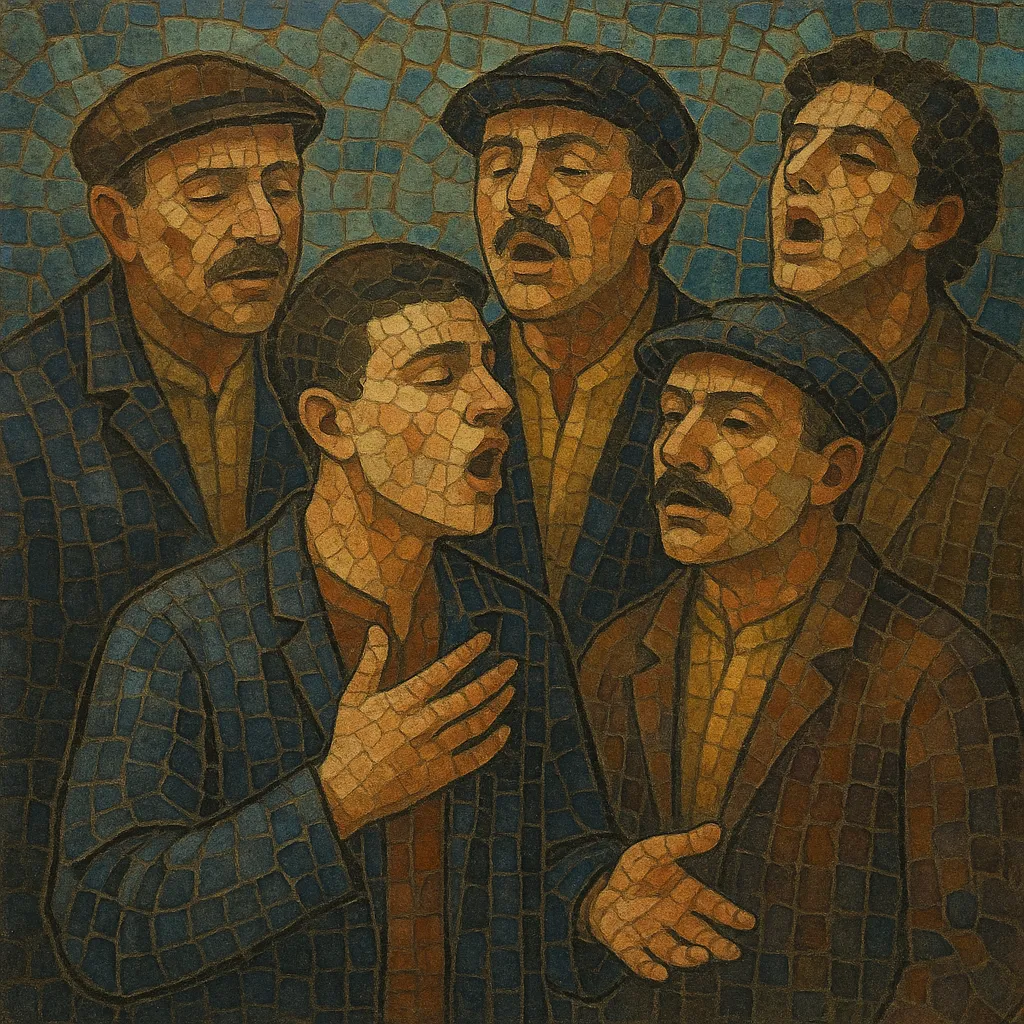Trallalero is a traditional male a cappella polyphonic singing style from the Ligurian region around Genoa, Italy. Ensembles perform without instruments, weaving five or more independent vocal parts into bright, ringing harmonies that often move with dance-like energy.
A distinctive hallmark is the “chitarra” voice, a specialized part that imitates a guitar’s rhythmic arpeggios using non-lexical syllables, underpinning the harmonic framework in lieu of actual instruments. Typical parts include a lead tenor (primmu), second tenor (secondu), a high falsetto alto (contràto), baritone, bass (bassu), and the chitarra. The texts are commonly in the Genoese (Zeneize) dialect, drawing on serenades, love songs, and urban folk narratives.
Trallalero balances rough, work-song vigor with refined, close-harmony craft, producing a sound that is at once communal, agile, and rhythmically buoyant.
Trallalero took shape in the 1800s among urban and port communities in and around Genoa, where groups of male singers developed an a cappella polyphonic practice for social gatherings, taverns, and outdoor serenades. The name likely derives from a lilting nonsense refrain ("tra-la-lè-ro") common in the genre’s strophic songs. Its structure reflects both local folk practice and older Italian polyphonic habits, adapted to an everyday, non-liturgical context.
By the early 1900s, trallalero had stabilized into ensembles with defined parts: a lead tenor (primmu), second tenor (secondu), contràto (a falsetto alto), baritone, bass, and a unique “chitarra” voice mimicking guitar arpeggiation. Repertoires included love songs, narratives, and serenades in Genoese dialect, performed in squares, workers’ circles, and festivals. The idiom became a badge of local identity among dockworkers and artisans.
Urban change, mass media, and shifting leisure habits reduced public practice in the mid-20th century. From the 1970s onward, ethnomusicologists, local cultural associations, and committed ensembles began documenting and revitalizing the style through recordings, contests, and workshops, helping codify technique and raise its profile beyond Liguria.
Today trallalero is sustained by dedicated groups, community festivals, and cultural institutions in Liguria and beyond. Ensembles continue to teach part-specific techniques (especially the chitarra and contràto), maintain dialect repertoire, and arrange new pieces that respect the idiom’s polyphonic balance and rhythmic lift.
Form a male a cappella ensemble with at least five parts: lead tenor (primmu), second tenor (secondu), contràto (high falsetto), baritone, bass, and a “chitarra” voice. The chitarra part simulates guitar-like arpeggios using percussive, non-lexical syllables (e.g., “din-din” patterns), providing rhythmic propulsion and harmonic scaffolding.
Aim for bright, ringing close-harmony chords with independent voice-leading. Keep the bass steady and well-centered to anchor intonation. The contràto should sit atop the texture with focused falsetto timbre, while the baritone and second tenor fill inner harmonies. Avoid overly choral vibrato; favor clear, forward tone and agile blending.
Use strophic forms with lively, dance-like pulse. The chitarra shapes rhythmic feel through repeated arpeggio cells; other parts enter in staggered phrases, creating interlocking motion. Cadences should be clear but buoyant, often ending on strong triads.
Write or adapt lyrics in Genoese (Zeneize) dialect when possible, drawing on serenade, love, and urban folk themes. Keep phrases compact and singable, allowing the lead tenor to carry the narrative while inner parts decorate lines with brief suspensions and passing tones.
Start with a simple triadic scheme and add suspensions or neighbor tones in inner parts. Use call-and-response between lead tenor and the rest, and punctuate with short chitarra ritornellos between verses.


